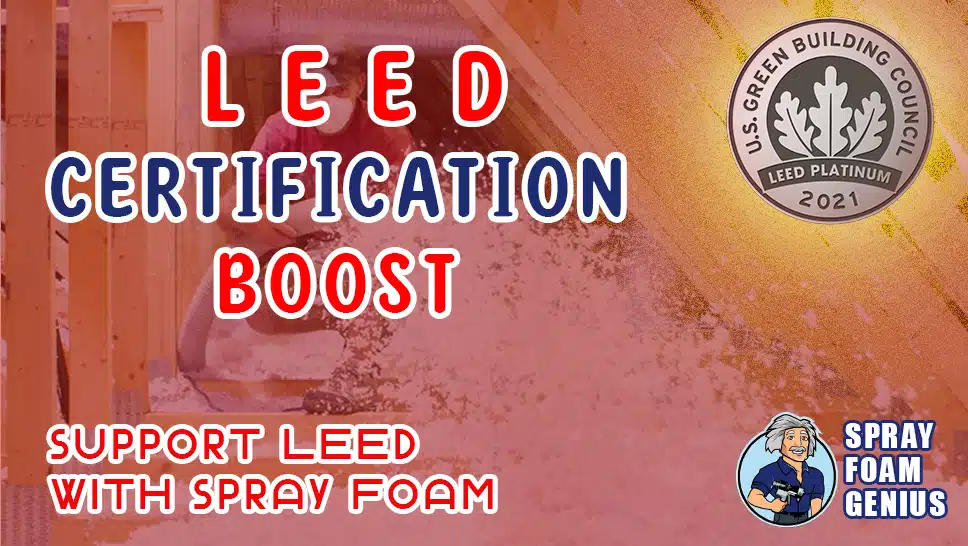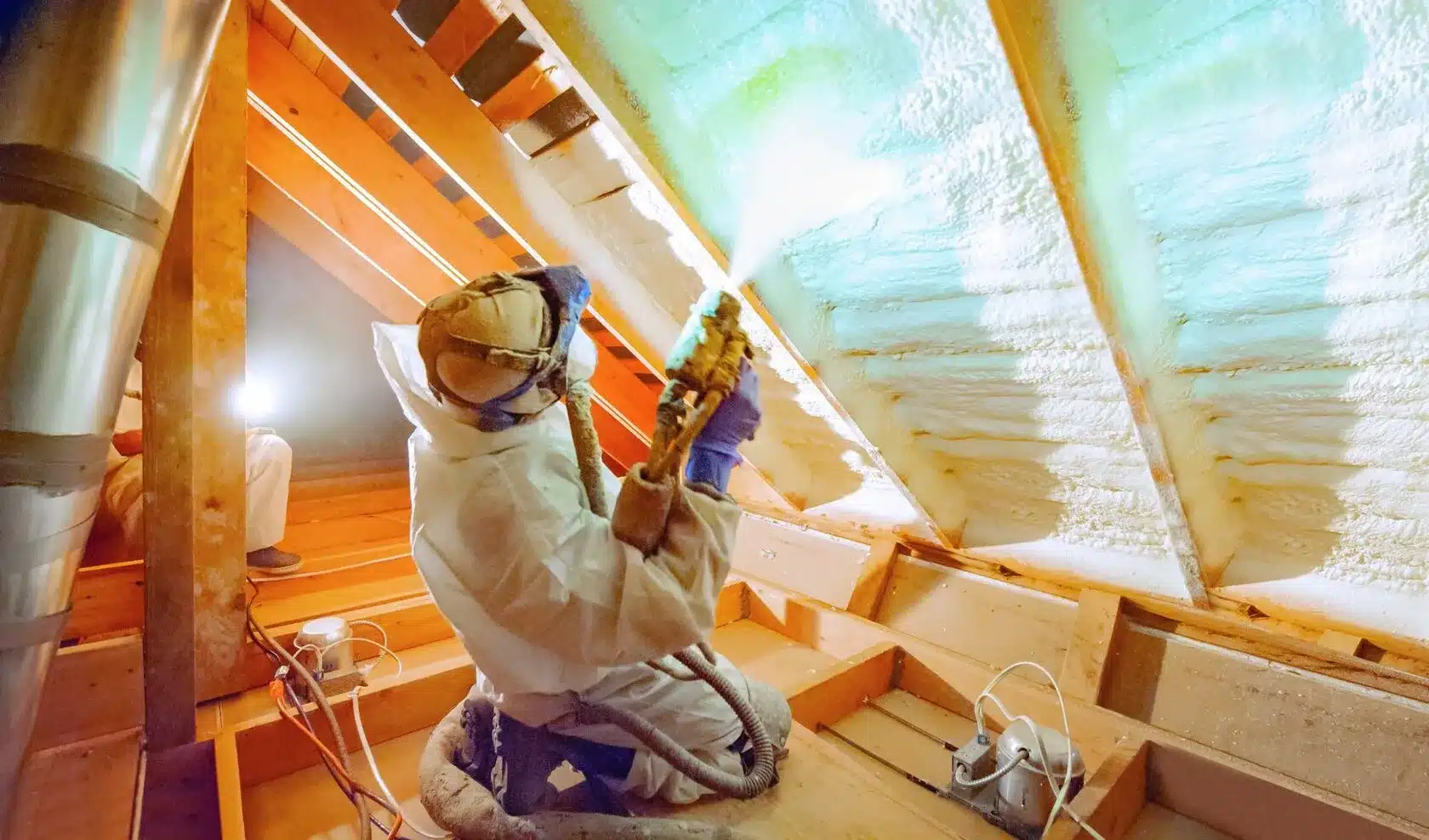
Achieving LEED (Leadership in Energy and Environmental Design) certification is a prestigious goal for any construction project aiming for sustainability. For spray foam insulation contractors, understanding how their services contribute to LEED certification is essential in a competitive green building market. This guide explores in-depth how spray foam insulation supports various LEED categories, helping contractors enhance their offerings and align with sustainable building practices.
What is LEED Certification?
LEED certification, developed by the U.S. Green Building Council (USGBC), is a globally recognized standard for green building. It provides a framework for designing, constructing, and operating high-performance green buildings. LEED certification is awarded based on points accumulated in several categories, including Energy and Atmosphere (EA), Indoor Environmental Quality (EQ), Materials and Resources (MR), and Innovation and Design Process (ID). Buildings can achieve one of four certification levels: Certified, Silver, Gold, and Platinum, depending on the number of points earned.
The Role of Spray Foam Insulation in LEED Certification
Spray foam insulation is a versatile and high-performance material that can significantly impact a building’s sustainability profile. Here’s how spray foam insulation contributes to achieving LEED certification across various categories:
1. Energy and Atmosphere (EA)
Energy Efficiency: Spray foam insulation is renowned for its superior thermal resistance. The material provides a high R-value per inch, which means it effectively resists heat flow. This characteristic helps maintain a consistent indoor temperature, reducing the need for heating and cooling systems. According to the USGBC, buildings that use high-performance insulation like spray foam can significantly lower their energy consumption, contributing to LEED credits related to energy efficiency.
Air Barrier: One of the key benefits of spray foam insulation is its ability to function as an air barrier. It seals gaps and cracks in the building envelope, minimizing air leaks that lead to energy loss. This characteristic is essential for meeting LEED’s requirements for air tightness and reducing energy consumption. The seamless application of spray foam ensures that even the smallest gaps are sealed, enhancing the building’s overall energy performance.
Thermal Comfort: Spray foam insulation contributes to better thermal comfort by maintaining stable indoor temperatures. This not only reduces energy consumption but also improves the comfort of building occupants. LEED places a strong emphasis on occupant comfort, and effective insulation plays a crucial role in meeting these standards.
2. Indoor Environmental Quality (EQ)
Improved Indoor Air Quality: Spray foam insulation helps enhance indoor air quality by reducing the infiltration of outdoor pollutants and allergens. The material’s ability to create a continuous barrier against external elements helps keep indoor air clean and healthy. This is particularly important for LEED credits related to indoor air quality, which focuses on the health and well-being of building occupants.
Moisture Control: Spray foam insulation provides excellent moisture control by creating a waterproof seal that prevents water infiltration. This helps to avoid moisture-related problems such as mold growth and musty odors. Proper moisture control is critical for maintaining a healthy indoor environment and is a key consideration in LEED credits related to indoor air quality and moisture management.
Reduced VOCs: Many modern spray foam insulation products are formulated to have low or zero volatile organic compounds (VOCs). VOCs can contribute to poor indoor air quality and health issues. By choosing low-VOC spray foam products, contractors can support LEED credits aimed at reducing the presence of harmful chemicals in building materials.
3. Materials and Resources (MR)
Sustainable Materials: The sustainability of spray foam insulation extends to its composition. Many products are made from recycled or renewable materials, which aligns with LEED’s focus on using sustainable building materials. The choice of eco-friendly materials contributes to LEED credits related to resource efficiency and environmental impact.
Longevity and Durability: Spray foam insulation is known for its durability and long lifespan. Unlike some traditional insulation materials that may degrade over time, spray foam maintains its performance and insulating properties for many years. This longevity reduces the need for frequent replacements and supports LEED’s emphasis on long-term sustainability and resource conservation.
Waste Reduction: The application of spray foam insulation is highly efficient, leading to minimal waste. The material can be precisely applied to fit the exact dimensions of the space, reducing excess material and construction waste. This aligns with LEED credits focused on minimizing construction and demolition waste.
4. Innovation and Design Process (ID)
Innovative Solutions: Spray foam insulation represents an innovative approach to achieving higher levels of energy efficiency and building performance. LEED encourages the adoption of advanced technologies and practices that contribute to sustainability. By incorporating spray foam insulation, contractors can demonstrate their commitment to innovative solutions in building design and construction.
Customization: One of the advantages of spray foam insulation is its ability to be customized to meet specific building needs. Whether dealing with complex architectural designs or unique insulation requirements, spray foam can be tailored to provide effective solutions. This flexibility supports LEED credits related to innovative design and the integration of customized solutions.
Practical Benefits for Spray Foam Contractors
Understanding how spray foam insulation supports LEED certification offers several practical benefits for contractors:
1. Enhanced Market Position
Aligning your services with LEED certification requirements enhances your market position as a leader in sustainable building practices. As more construction projects aim for green building standards, having expertise in spray foam insulation can attract clients seeking environmentally friendly solutions. This can differentiate your business from competitors and establish you as a preferred choice for LEED-certified projects.
2. Increased Project Opportunities
The demand for LEED-certified buildings is growing, and so is the need for insulation solutions that support these goals. By offering spray foam insulation and highlighting its benefits for LEED certification, you can tap into this expanding market. This can lead to more project opportunities and increased business growth.
3. Improved Client Satisfaction
Providing clients with insulation solutions that contribute to LEED certification can significantly enhance their satisfaction. Achieving green building goals is often a top priority for clients, and your ability to support these objectives can lead to positive feedback, repeat business, and referrals.
4. Regulatory Compliance
Understanding LEED requirements helps ensure that your insulation solutions meet current building codes and standards. This not only supports the achievement of LEED certification but also ensures compliance with regulations, reducing the risk of project delays or compliance issues.
Best Practices for Implementing Spray Foam Insulation

To maximize the benefits of spray foam insulation and effectively support LEED certification, consider these best practices:
1. Professional Installation
Proper installation of spray foam insulation is critical to achieving the desired performance and meeting LEED requirements. Ensure that your team is trained and certified in spray foam application techniques. Professional installation helps to ensure that the insulation performs as expected and contributes to energy efficiency and indoor air quality.
2. Quality Products
Select high-quality spray foam products that meet industry standards and LEED criteria. Verify product certifications and environmental claims to ensure that they align with LEED objectives. High-quality materials contribute to the overall effectiveness of the insulation and support the achievement of LEED credits.
3. Detailed Documentation
Maintain comprehensive documentation of insulation installation, including product specifications, installation procedures, and performance data. This documentation is essential for demonstrating compliance with LEED requirements and provides a record of the materials and methods used in the project.
4. Ongoing Maintenance
Implement a maintenance plan to ensure that spray foam insulation continues to perform optimally over time. Regular inspections and maintenance help to sustain energy efficiency and indoor air quality. Address any issues promptly to maintain the building’s performance and support LEED certification goals.
Get Started Today!
Spray foam insulation plays a crucial role in supporting LEED certification by enhancing energy efficiency, indoor air quality, and overall building performance. For spray foam contractors, leveraging these benefits can lead to increased market opportunities, improved client satisfaction, and alignment with sustainable building practices. By adopting best practices and understanding the impact of spray foam insulation on LEED certification, you can position your business as a leader in green construction. For more information on how our SEO and digital marketing services can help your spray foam insulation business thrive, visit our website at Spray Foam Genius Marketing or contact Spray Foam Genius Marketing at 877-840-FOAM for USA and 844-741-FOAM for Canada [email protected]. We’re here to help you reach your business goals and succeed in the competitive market of spray foam insulation.
- How to Use Pinterest to Market Your Spray Foam Insulation Services - December 27, 2023
- How to Use LinkedIn to Grow Your Spray Foam Insulation Business - December 23, 2023
- How to Use Instagram to Showcase Your Spray Foam Insulation Projects - December 16, 2023

